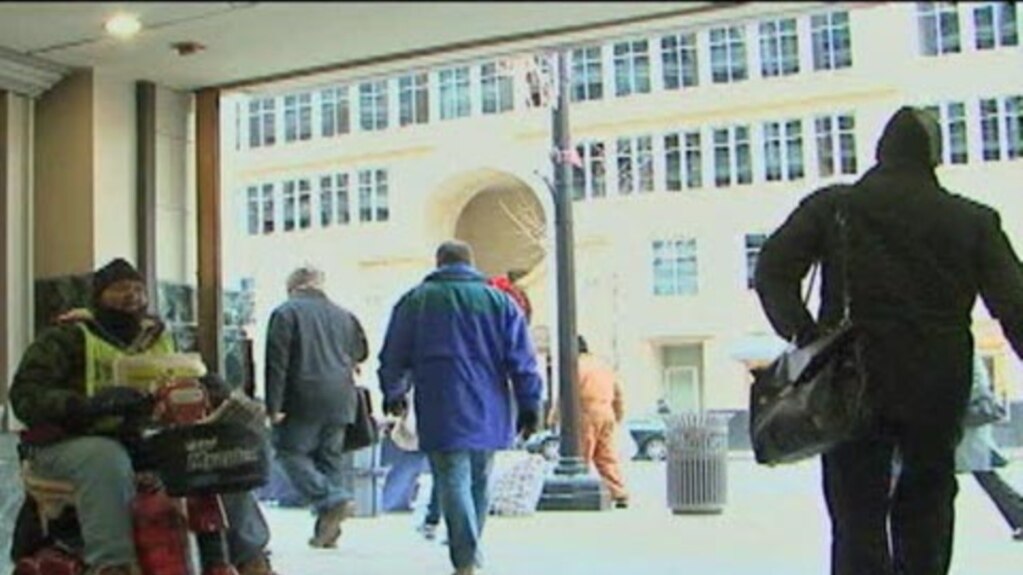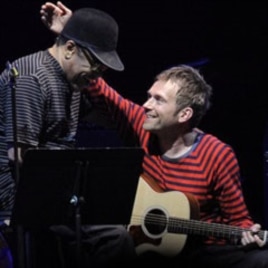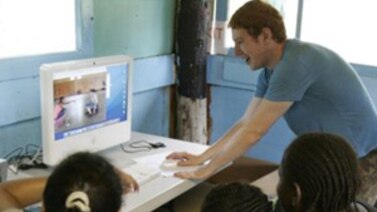
DOUG JOHNSON: Welcome to AMERICAN MOSAIC in VOA Special English.
(MUSIC)
I'm Doug Johnson.
This week we play music by Gorillaz...
And answer a question from Vietnam about Secretary of State Hillary Clinton...
But first, we tell about a Washington, D.C., newspaper of the homeless, by the homeless and for all people.
(MUSIC)
Street Sense
DOUG JOHNSON: Street Sense is a newspaper in Washington, D.C. about homeless people and issues that affect them. Homeless, or formerly homeless, Washingtonians write many of the articles. The newspaper’s business model is based on homeless vendors who sell the newspaper. You can hear them call out “Street Sense for sale!” near subway entrances, lunch places and other areas around the city.
Mario Ritter has more.
MARIO RITTER: The Street Sense newspaper is housed in an office in a Christian church in Washington. Every other Wednesday about fourteen thousand copies are printed. The newspaper expresses the thoughts and experiences of people who call the streets home.
Four staff members work at Street Sense. Two of them are paid. The staff members write the first two pages of the paper. Interns -- students working as part of their studies -- and volunteers help. Homeless writers provide the rest of the material. This includes poems, stories and essays.
Mary Otto is the editor of Street Sense. She came to the paper from the Washington Post newspaper. She had won a year-long fellowship at Harvard University for writing about the homeless.
MARY OTTO: “Some people are homeless for a few days and some are homeless for most of their lives.”
Mary Otto says severe mental disorders prevent many homeless people from seeking shelter. Such problems can also block them from having close relationships with other people.
Street Sense provides training to the homeless people who want to become part of the sales team. After the training, each student is given ten free copies of Street Sense. Once those are sold, trainees become real sales people. They buy papers for thirty-five cents each and sell them for a dollar.
Lisa Gillespie is the managing editor of Street Sense. She says the newspaper plays a part in homeless people’s lives that other media can not.
LISA GILLESPIE: “The mainstream media does not usually cover poverty or homelessness too much, unless someone dies or there’s a big rally or something.”
(SOUND: Veeda Simpson singing)
Veeda Simpson has been selling Street Sense for four years. She has a group of usual buyers.
The people like the paper and Ms. Simpson’s voice. Now, she and her eight cats have a home.
Critics say Street Sense is an excuse for the homeless to remain homeless. But the sales people say it permits them to be active and earn money while being their own employer.
(MUSIC)
Hillary Clinton
Our listener question this week comes from Vietnam. Nguyen Thanh Do wants to know about the political life of Hillary Clinton.
Hillary Diane Rodham began her political career as a student in Park Ridge, Illinois, near Chicago. She served as class president of her high school.
Hillary continued to be interested in politics as a student at Wellesley College for women, in Massachusetts. She began college as a Republican. She even served for a short time as president of the College Republicans.
But she soon resigned her position after realizing that many of her beliefs did not agree with Republican principles. She became a Democrat soon after.
Hillary Rodham was president of her graduating class at Wellesley in nineteen sixty-nine. She was the first student ever to give the school’s graduation speech. She went on to study at Yale Law School in Connecticut. She met another law school student, Bill Clinton. They married in nineteen seventy-five.

Hillary Clinton has been a strong supporter of women’s rights and issues involving children and families. She has also been a champion of health care reform.
In the nineteen seventies, she was a member of the presidential impeachment committee in the Watergate corruption investigation of President Richard Nixon.
She went on to become a successful lawyer and an assistant professor at the University of Arkansas School of Law. Mrs. Clinton served as first lady of Arkansas for twelve years while Bill Clinton was governor.
During that time, she worked to improve the education system in Arkansas. She also served on the Children’s Defense Fund and the Arkansas Advocates for Children and Families, an organization she helped create.
She became first lady of the United States in nineteen ninety-three, after Bill Clinton was elected president. In nineteen ninety-seven she helped launched the Vital Voices Democracy Initiative to promote the leadership of women as a foreign policy goal.
In two thousand, Hillary Clinton was elected to the United States Senate. No other first lady had ever done this. And in two thousand eight she carried out a historic campaign for president.
President Obama nominated Hillary Clinton as secretary of state. Secretary Clinton has traveled around the world spreading the message of democracy and human rights for all, but especially for women. She says women’s rights and human rights are one and the same.
(MUSIC)
Gorillaz/"The Fall"
DOUG JOHNSON: Gorillaz is a band led by British musician Damon Albarn. All of the songs on their newest album “The Fall” were recorded using Apple’s iPad device. The album was recorded during the band’s North American tour, October third to November second. Many of the songs reflect the place where the music was recorded.
Shirley Griffith tells us more.
(MUSIC)
SHIRLEY GIRIFFITH: That was the song “Revolving Doors.” It was recorded in Boston, Massachusetts. Damon Albarn is the only permanent member of Gorillaz. He created the band with the comic book artist Jamie Hewlett. Other band members change periodically depending on the album performance.
The Fall is unusual because it was not recorded using a sound studio. Gorillaz used an iPad and about twenty iPad programs, or apps, to make the album. Some songs also include tradition instruments such as the guitar, piano and several kinds of electronic instruments.
“The Parish of Space Dust” was recorded in Houston, Texas. It includes recordings of several local radio stations.
(MUSIC)
Imaginary characters are an important part of Gorillaz performances. When the band performs, images of cartoon characters are shown on huge screens. These characters are considered the band’s virtual band members. They include Noodle, 2D, and Murdoc Niccals. Fans can explore the lives of these characters on the Gorillaz website.

We leave you with “Bobby in Phoenix.” Soul musician Bobby Womack sings and plays the guitar in this song recorded in Phoenix, Arizona.
(MUSIC)
DOUG JOHNSON: I’m Doug Johnson. Our program was written by June Simms, Dana Demange and Caty Weaver who was also the producer.
If you have a question about American life, write to mosaic@voanews.com. We might answer your question on this show. So please include your name and country.
Join us again next week for AMERICAN MOSAIC, VOA’s radio magazine in Special English.
(MUSIC)
